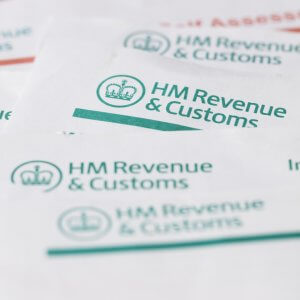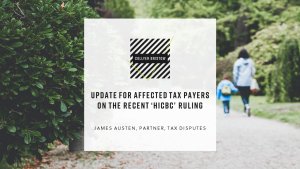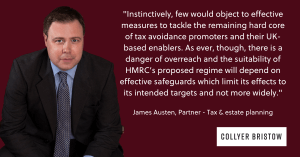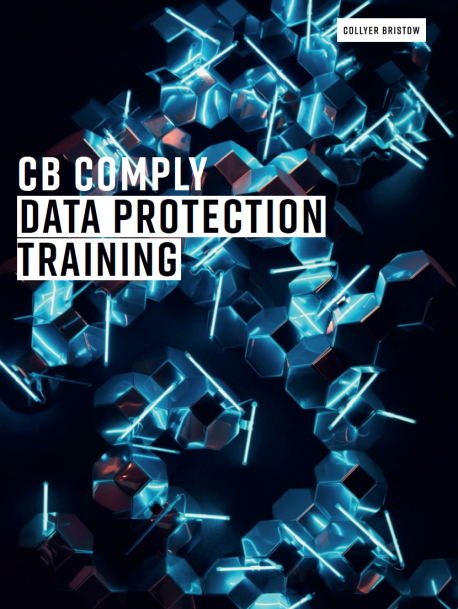- Tax & Estate Planning
- Tax disputes & investigations
- UK trusts, tax and estate planning
- UK/USA tax & estate planning

Longer Reads
Lessons from Angela Rayner’s SDLT errors
In their latest FT Adviser article, Partner James Austen and Trainee Solicitor Tom Mills explore the complexities of Stamp Duty Land Tax (SDLT) highlighted by Angela Rayner’s recent tax error, showing why even seemingly straightforward transactions can carry hidden risks.
7 minute read
Published 6 October 2025
Key information
In the fast-paced world of politics, personal financial matters can quickly become public scrutiny magnets, often revealing tax law’s intricacies that most individuals, even politicians, will be blissfully unaware of.
The recent controversy surrounding Angela Rayner, former deputy prime minister, is a stark illustration of this.
In September 2025 Rayner admitted underpaying stamp duty land tax on the purchase of an £800,000 flat in Hove, East Sussex, for which she self-referred to the prime minister’s Independent Adviser on Ministerial Standards, Sir Laurie Magnus.
Magnus’ ensuing investigation concluded that Rayner had breached the ministerial code by failing to meet “the highest standards of conduct” required of government ministers.
Magnus reached that conclusion primarily because she had not sought specialist tax advice on her SDLT position amid unusually complex family arrangements — crucially, despite having been advised to do so. Even though Rayner’s mistake had been made in good faith, that conclusion inevitably resulted in her resignation from government.
Rayner’s predicament highlights how even inadvertent tax errors can have profound personal and professional consequences. It also neatly encapsulates the surprising complexity of tax law in the UK — especially where legislation ‘deems’ something to be the case for tax purposes, even when it is not ‘in real life’.
Whilst few people are likely to be caught by the particular provision that did for Rayner, the wider issues raised by the case are of general application and illustrate the need for particular care — and appropriate expert advice — whenever unusual factual circumstances are relevant.
Rayner’s issue arose because of the ownership of her family home in Ashton-under-Lyne, whereby a portion of the property was held in trust for her disabled son. After selling her remaining 25 per cent interest in the Ashton-under-Lyme house to that trust and upon purchasing the Hove flat, this arrangement triggered the higher rate of SDLT.
The relevant provisions (s55 (4A) and paragraph 12, schedule 4ZA Finance Act 2003) — all statutory references are to this act unless specified otherwise — applied because the child’s beneficial interest was ‘deemed’ to constitute Rayner’s ownership of an additional dwelling for SDLT purposes even though as a matter of fact she had no continuing beneficial interest in that property.
The issue is that SDLT does not operate simply or transparently where trusts are concerned. Initially, paragraph 10, schedule 4ZA addresses trusts where a beneficiary is entitled to occupy the dwelling for life or receive income from it, treating the beneficiary (in this case, the child) as the purchaser rather than the trustee: it operates to shift the SDLT position depending on the beneficiary’s status.
However, paragraph 12 then attributes that interest back to a parent for SDLT purposes if, as here, the trust beneficiary is under the age of 18. So in Rayner’s case, her son’s interest in the family home (valued at over £40,000) meant she was deemed to hold a major interest in an additional dwelling, meaning the Hove purchase was liable for the higher rate — typically 3 percentage points above the standard rate, and applying to the whole of the purchase price.
Ignorant of her actual tax position, and having failed to take the expert advice she was advised to obtain, Rayner initially paid the standard rate of SDLT. Following sustained and intense political and press scrutiny, she later acknowledged her mistake and (one infers) filed a corrective SDLT return with HMRC to rectify the prior underpayment, estimated variously to have been between £40,000 and £70,000.
The personal tragedy for Rayner is that had she asked a suitably experienced professional with expertise in SDLT matters, she could have learned the actual position in a few minutes: the answer to the technical question raised by her case is obvious to anyone familiar with these rules.
Why is SDLT so complex?
SDLT’s evolution since its 2003 introduction reflects a wider trend in UK tax law, in which every finance bill introduces layer upon layer of new complexity, rendering the UK’s burgeoning tax code one of the most convoluted in the world.
The underlying reasons for this process are twofold: first, governments generally wish to extract as much tax revenue as possible from existing taxes, so they continually ‘bolt on’ new liabilities to once-logical tax regimes; secondly, politicians (of all parties) and HMRC share the persistent concern — bordering on paranoia — about public backlash if tax ‘loopholes’ are exploited.
Because of these factors, SDLT (like most other UK taxes) has been repeatedly amended to increase tax for some purchasers and/or to plug gaps that might permit tax avoidance.
These changes have created a patchwork of rules, where even some standard property transactions risk misclassification without expert advice; complex or unusual transactions will nearly always require expert SDLT input in advance. In Rayner’s case, Magnus’ report highlighted this, noting the “considerable degree of complexity” in interpreting trust-related provisions.
Higher rates and determining whether a property is a first or second home
Determining if a property is a first or second (or subsequent) home for SDLT hinges on whether the purchaser owns a ‘major interest’ in another dwelling (with an open-market value of £40,000 or more) at the effective date of a relevant transaction. A major interest in residential property includes freeholds or leases over 21 years. Since 2021, property ownership is assessed globally, including overseas properties for non-residents. As seen above, complexities abound.
Upon buying a first or only residential property, standard SDLT rates typically apply. These are graduated, from 0 per cent on the value up to £125,000, rising to 12 per cent on the value over £1.5mn. For second (or subsequent) homes, those rates continue to apply, but with the addition of a now 5 per cent surcharge, which applies to the whole consideration value.
The key test is this: at the day’s end, is a buyer treated for SDLT purposes as owning another dwelling? If the answer to that question is yes, then the additional property surcharge will apply.
If a buyer purchases a new property with the intention of replacing a main residence, but where the original residence was not disposed of by the time of the acquisition of the replacement, he/she must pay the 3 per cent surcharge in the first instance, though may reclaim that if the first property is subsequently sold within three years of the purchase of the second property.
Residential properties worth up to £499,999.99 bought by companies are also subject to the 5 per cent surcharge, whilst high value residential properties (of £500,000+) bought by companies or partnerships are subject to a 17 per cent flat rate of SDLT on the entire consideration (though not subject to the additional 5 per cent surcharge on top of that).
Meanwhile, a further, additional, 2 per cent surcharge is payable by non-UK purchasers of UK residential property. Meaning that the top rate of SDLT is presently 19 per cent on the whole value of the consideration paid for a UK property by a non-UK company.
What happens when residential property is put in trust? Do trusts pay SDLT?
In appropriate circumstances, transferring UK property (or an interest in it) to trust is common practice. At the same time, there are invariably tax considerations to doing so (including inheritance tax and capital gains tax). The SDLT implications can also add significant complexity.
In principle, at least in the abstract, trusts are treated in the same way as any other property purchaser. So transferring residential property into trust does trigger SDLT if the trustees give “chargeable consideration” for it — typically, either money being paid or the assumption of a debt (for example, a mortgage).
For straightforward no-consideration transactions, such as a gift into a trust, no SDLT will arise because such transfers are not included within the definition of a ‘land transaction’ having a value. But if consideration is treated as existing — even if no money is paid — then SDLT is calculated on the amount of the actual or deemed consideration at the prevailing rate(s). For example, if a parent sells a share of a house to a trust for market value, SDLT will apply to the trustees in the usual way.
The type of trust matters crucially. For example, in a bare trust, where the beneficiary is absolutely entitled to the property, the beneficiary is always treated as the owner for SDLT purposes (schedule 16). Similarly, in most ‘life interest’ trusts, where one or more (adult) beneficiaries is/are entitled to occupy trust property, they will typically be treated as owning that property for SDLT purposes.
Rayner’s difficulties have highlighted the position if a trust beneficiary under the age of 18 is the beneficial owner of trust property: the parent(s) will be treated as owning that property for SDLT purposes. Meanwhile, in discretionary trusts, in which no beneficiary has an entitlement to occupy trust property, purchases are treated as being made by the trustees, which attracts the higher rates as trusts are considered to be like companies for the purpose of SDLT’s additional dwellings rules, meaning the surcharge will apply even on first purchases. Additionally, no relief for first-time buyers or main residences is available, as trusts do not themselves ‘reside’.
All these differing rules mean that transfers may or may not incur SDLT if there is no actual or deemed consideration in the first instance, whilst future transactions could attract higher rates if the beneficiary (or his/her parent(s)) own(s) other properties. It is a mess; whilst the rules are familiar to experts, they will be opaque and difficult to follow for ordinary taxpayers.
Penalties
One issue that has not widely been discussed in the press is whether Rayner should be liable for a tax-geared penalty as a result of the acknowledged inaccuracy in the original SDLT return filed on her behalf.
Penalties are charged under schedule 24, Finance Act 2007, if the taxpayer’s conduct leading to the inaccuracy was culpable as either “careless” or “deliberate” behaviour. A “careless” inaccuracy is defined as one which was “due to failure by [the taxpayer] to take reasonable care”, and Rayner’s error was certainly no more than careless: it was clearly a mistake, and not deliberate.
Schedule 24, Finance Act 2007, is mandatory: “A penalty is payable . . . ” — emphasis added — where a taxpayer files a return that understates his/her liability to tax and that inaccuracy was “careless”. Though penalties are not payable in cases of innocent error or where the taxpayer has a “reasonable excuse” for the inaccuracy. They can also be reduced or waived where there are “special circumstances”, where an “exceptional” factor unique to the taxpayer means that, as HMRC’s guidance at CH170800 puts it, “strict application of the penalty law may produce a result contrary to [parliament’s] clear intention.”
Some readers might think that Rayner has suffered enough and should not be penalised further for a genuine mistake. But as Magnus found when deciding that Rayner had broken the ministerial code, the reason for the understatement of her SDLT liability was that she had failed to take appropriate expert advice, even though she had been advised to do so several times.
On the face of it, that would seem to sit squarely within the category of “careless” conduct. And whilst Rayner should not be subjected to worse treatment than other taxpayers because of her public position, she should not be excused either. After all, a great many taxpayers are subjected to penalties for careless conduct, even where they have relied on suitably qualified (but ultimately incorrect) advice.
It would therefore treat Rayner unequally if HMRC do not issue her with a penalty when she failed to do take appropriate advice at all, despite knowing at the time that she should have done. It therefore seems likely that HMRC will issue her with a penalty notice.
On the upside for Rayner, because (one understands) she proactively and voluntarily notified the inaccuracy to HMRC, together with all the information needed for HMRC to correct her return, HMRC should give her the maximum possible penalty reductions for so-called “helping, telling, and giving”.
Rayner’s ultimate penalty is therefore likely to be only 15 per cent to 30 per cent of the “potential lost revenue” — that is, the amount by which she originally understated her SDLT liability.
Conclusions: key lessons and the imperative of expert advice
Rayner’s tax affairs luridly illuminate the perils of underestimating SDLT’s complexity. While most residential purchases are straightforward, situations involving trusts, family interests, or multiple properties invoke specialised rules like those in schedule 4ZA, which can unexpectedly elevate liabilities.
For advisers, the lessons are clear: clients should be specifically advised and encouraged to consult suitably qualified and experienced tax experts early, especially where there is any indication of non-standard arrangements.
To elicit relevant details, property professionals should always ask purchasers whether or not there are any trusts in existence, and if there are, the matter should always be referred to an SDLT expert. In addition, for their own protection, conveyancers who are content to prepare and file SDLT returns for their clients on an execution-only basis, pursuant to their clients’ instructions and in reliance on HMRC’s online SDLT calculator, should ensure that their terms of engagement clearly delineate their responsibilities, and provide that all tax liability/risk lies on the client and not on them.
As Rayner ruefully commented, family arrangements are “rarely straightforward”; a reminder that even supposedly simple taxes like SDLT demand vigilance if costly and damaging mistakes are to be avoided.
This article was originally published to FT Advisor on 30 September 2025. You can read it on the FT Adviser website here.
Related content
Longer Reads
Lessons from Angela Rayner’s SDLT errors
In their latest FT Adviser article, Partner James Austen and Trainee Solicitor Tom Mills explore the complexities of Stamp Duty Land Tax (SDLT) highlighted by Angela Rayner’s recent tax error, showing why even seemingly straightforward transactions can carry hidden risks.
Published 6 October 2025
Associated sectors / services
Authors
In the fast-paced world of politics, personal financial matters can quickly become public scrutiny magnets, often revealing tax law’s intricacies that most individuals, even politicians, will be blissfully unaware of.
The recent controversy surrounding Angela Rayner, former deputy prime minister, is a stark illustration of this.
In September 2025 Rayner admitted underpaying stamp duty land tax on the purchase of an £800,000 flat in Hove, East Sussex, for which she self-referred to the prime minister’s Independent Adviser on Ministerial Standards, Sir Laurie Magnus.
Magnus’ ensuing investigation concluded that Rayner had breached the ministerial code by failing to meet “the highest standards of conduct” required of government ministers.
Magnus reached that conclusion primarily because she had not sought specialist tax advice on her SDLT position amid unusually complex family arrangements — crucially, despite having been advised to do so. Even though Rayner’s mistake had been made in good faith, that conclusion inevitably resulted in her resignation from government.
Rayner’s predicament highlights how even inadvertent tax errors can have profound personal and professional consequences. It also neatly encapsulates the surprising complexity of tax law in the UK — especially where legislation ‘deems’ something to be the case for tax purposes, even when it is not ‘in real life’.
Whilst few people are likely to be caught by the particular provision that did for Rayner, the wider issues raised by the case are of general application and illustrate the need for particular care — and appropriate expert advice — whenever unusual factual circumstances are relevant.
Rayner’s issue arose because of the ownership of her family home in Ashton-under-Lyne, whereby a portion of the property was held in trust for her disabled son. After selling her remaining 25 per cent interest in the Ashton-under-Lyme house to that trust and upon purchasing the Hove flat, this arrangement triggered the higher rate of SDLT.
The relevant provisions (s55 (4A) and paragraph 12, schedule 4ZA Finance Act 2003) — all statutory references are to this act unless specified otherwise — applied because the child’s beneficial interest was ‘deemed’ to constitute Rayner’s ownership of an additional dwelling for SDLT purposes even though as a matter of fact she had no continuing beneficial interest in that property.
The issue is that SDLT does not operate simply or transparently where trusts are concerned. Initially, paragraph 10, schedule 4ZA addresses trusts where a beneficiary is entitled to occupy the dwelling for life or receive income from it, treating the beneficiary (in this case, the child) as the purchaser rather than the trustee: it operates to shift the SDLT position depending on the beneficiary’s status.
However, paragraph 12 then attributes that interest back to a parent for SDLT purposes if, as here, the trust beneficiary is under the age of 18. So in Rayner’s case, her son’s interest in the family home (valued at over £40,000) meant she was deemed to hold a major interest in an additional dwelling, meaning the Hove purchase was liable for the higher rate — typically 3 percentage points above the standard rate, and applying to the whole of the purchase price.
Ignorant of her actual tax position, and having failed to take the expert advice she was advised to obtain, Rayner initially paid the standard rate of SDLT. Following sustained and intense political and press scrutiny, she later acknowledged her mistake and (one infers) filed a corrective SDLT return with HMRC to rectify the prior underpayment, estimated variously to have been between £40,000 and £70,000.
The personal tragedy for Rayner is that had she asked a suitably experienced professional with expertise in SDLT matters, she could have learned the actual position in a few minutes: the answer to the technical question raised by her case is obvious to anyone familiar with these rules.
Why is SDLT so complex?
SDLT’s evolution since its 2003 introduction reflects a wider trend in UK tax law, in which every finance bill introduces layer upon layer of new complexity, rendering the UK’s burgeoning tax code one of the most convoluted in the world.
The underlying reasons for this process are twofold: first, governments generally wish to extract as much tax revenue as possible from existing taxes, so they continually ‘bolt on’ new liabilities to once-logical tax regimes; secondly, politicians (of all parties) and HMRC share the persistent concern — bordering on paranoia — about public backlash if tax ‘loopholes’ are exploited.
Because of these factors, SDLT (like most other UK taxes) has been repeatedly amended to increase tax for some purchasers and/or to plug gaps that might permit tax avoidance.
These changes have created a patchwork of rules, where even some standard property transactions risk misclassification without expert advice; complex or unusual transactions will nearly always require expert SDLT input in advance. In Rayner’s case, Magnus’ report highlighted this, noting the “considerable degree of complexity” in interpreting trust-related provisions.
Higher rates and determining whether a property is a first or second home
Determining if a property is a first or second (or subsequent) home for SDLT hinges on whether the purchaser owns a ‘major interest’ in another dwelling (with an open-market value of £40,000 or more) at the effective date of a relevant transaction. A major interest in residential property includes freeholds or leases over 21 years. Since 2021, property ownership is assessed globally, including overseas properties for non-residents. As seen above, complexities abound.
Upon buying a first or only residential property, standard SDLT rates typically apply. These are graduated, from 0 per cent on the value up to £125,000, rising to 12 per cent on the value over £1.5mn. For second (or subsequent) homes, those rates continue to apply, but with the addition of a now 5 per cent surcharge, which applies to the whole consideration value.
The key test is this: at the day’s end, is a buyer treated for SDLT purposes as owning another dwelling? If the answer to that question is yes, then the additional property surcharge will apply.
If a buyer purchases a new property with the intention of replacing a main residence, but where the original residence was not disposed of by the time of the acquisition of the replacement, he/she must pay the 3 per cent surcharge in the first instance, though may reclaim that if the first property is subsequently sold within three years of the purchase of the second property.
Residential properties worth up to £499,999.99 bought by companies are also subject to the 5 per cent surcharge, whilst high value residential properties (of £500,000+) bought by companies or partnerships are subject to a 17 per cent flat rate of SDLT on the entire consideration (though not subject to the additional 5 per cent surcharge on top of that).
Meanwhile, a further, additional, 2 per cent surcharge is payable by non-UK purchasers of UK residential property. Meaning that the top rate of SDLT is presently 19 per cent on the whole value of the consideration paid for a UK property by a non-UK company.
What happens when residential property is put in trust? Do trusts pay SDLT?
In appropriate circumstances, transferring UK property (or an interest in it) to trust is common practice. At the same time, there are invariably tax considerations to doing so (including inheritance tax and capital gains tax). The SDLT implications can also add significant complexity.
In principle, at least in the abstract, trusts are treated in the same way as any other property purchaser. So transferring residential property into trust does trigger SDLT if the trustees give “chargeable consideration” for it — typically, either money being paid or the assumption of a debt (for example, a mortgage).
For straightforward no-consideration transactions, such as a gift into a trust, no SDLT will arise because such transfers are not included within the definition of a ‘land transaction’ having a value. But if consideration is treated as existing — even if no money is paid — then SDLT is calculated on the amount of the actual or deemed consideration at the prevailing rate(s). For example, if a parent sells a share of a house to a trust for market value, SDLT will apply to the trustees in the usual way.
The type of trust matters crucially. For example, in a bare trust, where the beneficiary is absolutely entitled to the property, the beneficiary is always treated as the owner for SDLT purposes (schedule 16). Similarly, in most ‘life interest’ trusts, where one or more (adult) beneficiaries is/are entitled to occupy trust property, they will typically be treated as owning that property for SDLT purposes.
Rayner’s difficulties have highlighted the position if a trust beneficiary under the age of 18 is the beneficial owner of trust property: the parent(s) will be treated as owning that property for SDLT purposes. Meanwhile, in discretionary trusts, in which no beneficiary has an entitlement to occupy trust property, purchases are treated as being made by the trustees, which attracts the higher rates as trusts are considered to be like companies for the purpose of SDLT’s additional dwellings rules, meaning the surcharge will apply even on first purchases. Additionally, no relief for first-time buyers or main residences is available, as trusts do not themselves ‘reside’.
All these differing rules mean that transfers may or may not incur SDLT if there is no actual or deemed consideration in the first instance, whilst future transactions could attract higher rates if the beneficiary (or his/her parent(s)) own(s) other properties. It is a mess; whilst the rules are familiar to experts, they will be opaque and difficult to follow for ordinary taxpayers.
Penalties
One issue that has not widely been discussed in the press is whether Rayner should be liable for a tax-geared penalty as a result of the acknowledged inaccuracy in the original SDLT return filed on her behalf.
Penalties are charged under schedule 24, Finance Act 2007, if the taxpayer’s conduct leading to the inaccuracy was culpable as either “careless” or “deliberate” behaviour. A “careless” inaccuracy is defined as one which was “due to failure by [the taxpayer] to take reasonable care”, and Rayner’s error was certainly no more than careless: it was clearly a mistake, and not deliberate.
Schedule 24, Finance Act 2007, is mandatory: “A penalty is payable . . . ” — emphasis added — where a taxpayer files a return that understates his/her liability to tax and that inaccuracy was “careless”. Though penalties are not payable in cases of innocent error or where the taxpayer has a “reasonable excuse” for the inaccuracy. They can also be reduced or waived where there are “special circumstances”, where an “exceptional” factor unique to the taxpayer means that, as HMRC’s guidance at CH170800 puts it, “strict application of the penalty law may produce a result contrary to [parliament’s] clear intention.”
Some readers might think that Rayner has suffered enough and should not be penalised further for a genuine mistake. But as Magnus found when deciding that Rayner had broken the ministerial code, the reason for the understatement of her SDLT liability was that she had failed to take appropriate expert advice, even though she had been advised to do so several times.
On the face of it, that would seem to sit squarely within the category of “careless” conduct. And whilst Rayner should not be subjected to worse treatment than other taxpayers because of her public position, she should not be excused either. After all, a great many taxpayers are subjected to penalties for careless conduct, even where they have relied on suitably qualified (but ultimately incorrect) advice.
It would therefore treat Rayner unequally if HMRC do not issue her with a penalty when she failed to do take appropriate advice at all, despite knowing at the time that she should have done. It therefore seems likely that HMRC will issue her with a penalty notice.
On the upside for Rayner, because (one understands) she proactively and voluntarily notified the inaccuracy to HMRC, together with all the information needed for HMRC to correct her return, HMRC should give her the maximum possible penalty reductions for so-called “helping, telling, and giving”.
Rayner’s ultimate penalty is therefore likely to be only 15 per cent to 30 per cent of the “potential lost revenue” — that is, the amount by which she originally understated her SDLT liability.
Conclusions: key lessons and the imperative of expert advice
Rayner’s tax affairs luridly illuminate the perils of underestimating SDLT’s complexity. While most residential purchases are straightforward, situations involving trusts, family interests, or multiple properties invoke specialised rules like those in schedule 4ZA, which can unexpectedly elevate liabilities.
For advisers, the lessons are clear: clients should be specifically advised and encouraged to consult suitably qualified and experienced tax experts early, especially where there is any indication of non-standard arrangements.
To elicit relevant details, property professionals should always ask purchasers whether or not there are any trusts in existence, and if there are, the matter should always be referred to an SDLT expert. In addition, for their own protection, conveyancers who are content to prepare and file SDLT returns for their clients on an execution-only basis, pursuant to their clients’ instructions and in reliance on HMRC’s online SDLT calculator, should ensure that their terms of engagement clearly delineate their responsibilities, and provide that all tax liability/risk lies on the client and not on them.
As Rayner ruefully commented, family arrangements are “rarely straightforward”; a reminder that even supposedly simple taxes like SDLT demand vigilance if costly and damaging mistakes are to be avoided.
This article was originally published to FT Advisor on 30 September 2025. You can read it on the FT Adviser website here.
Associated sectors / services
- Tax & Estate Planning
- Tax disputes & investigations
- UK trusts, tax and estate planning
- UK/USA tax & estate planning
Authors
Need some more information? Make an enquiry below.
Subscribe
Please add your details and your areas of interest below
Article contributors
James
AustenPartner
Specialising in UK trusts, tax & estate planning, Private wealth, Tax disputes & investigations and Trusts & Inheritance disputes
Enjoy reading our articles? why not subscribe to notifications so you’ll never miss one?
Subscribe to our articlesMessage us on WhatsApp (calling not available)
Please note that Collyer Bristow provides this service during office hours for general information and enquiries only and that no legal or other professional advice will be provided over the WhatsApp platform. Please also note that if you choose to use this platform your personal data is likely to be processed outside the UK and EEA, including in the US. Appropriate legal or other professional opinion should be taken before taking or omitting to take any action in respect of any specific problem. Collyer Bristow LLP accepts no liability for any loss or damage which may arise from reliance on information provided. All information will be deleted immediately upon completion of a conversation.
Close









































































